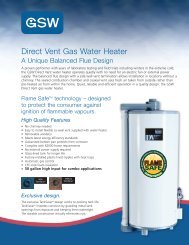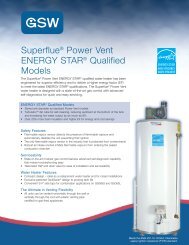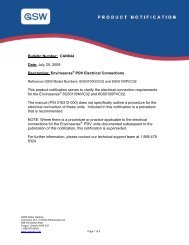Download PDF - GSW Water Heating
Download PDF - GSW Water Heating
Download PDF - GSW Water Heating
Create successful ePaper yourself
Turn your PDF publications into a flip-book with our unique Google optimized e-Paper software.
Pressure Build-Up (Thermal Expansion)<br />
During the heating cycle of the water heater, the water<br />
expands creating a pressure build-up in the plumbing system.<br />
If the pressure exceeds 150 psi, water will come out of<br />
the Temperature-Pressure (T&P) Relief Valve. This is a normal<br />
safety function of the T&P valve. The water supply<br />
meter may have a check valve or back flow preventer<br />
inside. This can increase the possibility of pressure buildup.<br />
Causes of discharge can be thermal expansion, excess<br />
system pressure, too high a temperature setting on the thermostat<br />
or something in the water heater causing excess<br />
temperatures in the heater.<br />
Thermal Expansion<br />
As water is heated, it expands (Thermal expansion). In a<br />
closed system the volume of water will grow when it is heated.<br />
As the volume of water grows there will be a corresponding<br />
increase in water pressure due to thermal expansion.<br />
Thermal expansion can cause premature tank failure (leakage).<br />
This type of failure is not covered under the limited<br />
warranty. Thermal expansion can also cause intermittent<br />
T&P valve operation: water discharged from the valve due<br />
to excess pressure build up. This condition is not covered<br />
under the limited warranty. The T&P valve is not intended<br />
for the constant relief of thermal expansion. A properly sized<br />
and charged thermal expansion tank must be installed on all<br />
closed systems to control the harmful effects of thermal<br />
expansion. To prevent the T&P valve from discharging hot<br />
water there are two (2) recommendations:<br />
OPTION 1: Install a 125 psi Pressure Relief (only) valve in<br />
the cold water supply line. Make sure that the discharge of<br />
this valve is directed to a drain to prevent water damage and<br />
it is protected from freezing,<br />
OR<br />
OPTION 2: Install an expansion tank on the cold water supply<br />
line. For every 50 U.S. gallons of stored water, the<br />
expansion tank must have a minimum capacity of 1.5 U.S.<br />
gallons. Contact a local plumbing service agency to have a<br />
thermal expansion tank installed.<br />
Electrical<br />
DO NOT apply power to this unit until it is completely filled<br />
with water.<br />
1. Check to see that the element marking and nameplate<br />
data correspond with the electric service available. The<br />
junction box where electrical connections are made is<br />
located near the top of the heater, near the upper<br />
access door.<br />
2. Install a circuit directly from the main fuse box. This circuit<br />
must be the right size for the length of run and the<br />
load (see Table 1).<br />
– 5 –<br />
MAX. MAX. VOLTS<br />
WATTS 120 V 208 V 240 V<br />
1500 20 A 10 A 10 A<br />
3000 35 A 20 A 20 A<br />
3500 40 A 20 A 20 A<br />
4500 30 A 25 A<br />
5500 35 A 35 A<br />
NOTE: <strong>Water</strong> heater must be well grounded to the electrical<br />
supply service.<br />
Table 1 Power Requirements<br />
3. A ground wire must run from the green ground screw<br />
provided at the electrical connection point in the heater<br />
junction box to the ground connection at the service<br />
panel.<br />
4. Adequate fusing must be provided at the service<br />
entrance as required by local codes and/or electric utility<br />
having jurisdiction. This can be accomplished with<br />
either a circuit breaker or fuse block in the service panel<br />
or a separate disconnect switch, so that electric power<br />
can be shut off easily when working on the heater.<br />
5. Final connections are made at the junction box in the<br />
heater. Access to the junction box is obtained by removing<br />
the cover near the knockouts.<br />
6. The heater you have received is internally wired. A specific<br />
wiring diagram is located inside the upper door or<br />
for certain models on the rating plate. All wiring is<br />
colour-coded and connections must be made as shown<br />
in the wiring diagram.<br />
Wiring<br />
TWO WIRE CIRCUIT FOR NON-SIMULTANEOUS OPER-<br />
ATION. SINGLE HIGH LIMIT.<br />
The basic operation of a two-thermostat system (upper and<br />
lower) on an electric water heater of 240 volts is as follows:<br />
Only one element will come on at any one time. This is<br />
known as a flip/flop system. On a 240 volt water heater,<br />
there will always be 120 volts to both elements. The thermostat<br />
will direct the second leg of the 120 volts to the element<br />
to complete the 240 volts required for energizing the<br />
element.<br />
Initial Start Up: When the tank is full of cold water, the<br />
upper thermostat will take priority and the top portion of the<br />
water will heat up to the setting of the thermostat. Once that<br />
temperature has been reached, the thermostat will then flip<br />
down the 120 volts to the lower thermostat. The thermostat<br />
switch closes and the bottom portion of the tank heats up<br />
until the water reaches the setting on that thermostat. At this<br />
point the tank will be full of hot water.<br />
Normal Operation: When hot water is being used, cold<br />
water enters the bottom of the heater (either bottom feed or<br />
by diptube), and the bottom element will begin to heat the<br />
cold water. If lots of hot water has been used, the upper<br />
thermostat will take priority and the top portion of the heater<br />
will be heated. Once heated, the thermostat will flip down to<br />
the lower thermostat to heat the lower portion.





